|
Kamasutra
Art Gallery - 3
|
|
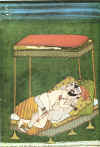 |
Lataveshta, the Clinging Creeper,
mentioned in two medieval texts, is the natural line arising from the Pidita-Veshtita
sequence given in Kama Sutra. Although the painting has
some Kashmiri features, it is probably a product of the Delhi bazaars.
It is interesting to think that paintings such as this were still
being made when Burton and Arbuthnot sat down with their pandits to make
their translation of Vatsyayana's text. Delhi, bazaar style,
nineteenth century. |
| The inscription to this lavishly ornamented
miniature describes the lovers as being in the Mudita (Gladenning)
posture, which results in great pleasure. The posture can develop
into Shulachita, or Jrimbhitaka. Or it the lady draws up
and extends her legs alternately, it would become the most celebrated of Kama
Sutra's postures, the Venudaritak, or Splitting Bamboo. Jaipur,
mid nineteenth century. |
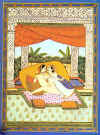 |
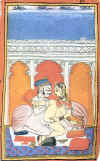 |
This rather difficult looking posture must owe
something of its strangeness to the painter's use of perspective. It
appears to be a variant of what Ratiratnapradipika describes as Shulanka,
which gets its name because, when seen from above, the man's stiff
body and the woman's raised legs resemble the three prongs of the trident.
Mewar c.1760 |
| A prince of Jodhpur and his wife in a difficult
variant of Bandhura, the Curved Knot. Did the lady ever
amuse herself with some of the priceless absurdities of the Jodhpur
treasury, like the pair of diamond eyebrows that hook, like spectacles,
over the ears? And she was one of those who left her handprints on
the wall of the Loha Gate of Jodhpur Fort as she went to immolate herself
on the funeral pyre of her husband, the Maharaja? Jodhpur early
eighteenth century. |
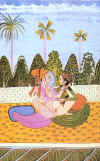 |
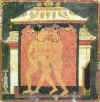 |
Nepalese tantrics in a simple standing
posture. They wear consecrated amulets and the man has a Gurkha
hat. Nepal was one of the strongholds of the tantric
tradition and many Nepalese temples - like rustic Khajurahos - are
embellished with gaudily painted woodcarvings of amorous couples. The
couple in this painting regard each other as man and woman, but as
embodiments of Parvati and Shiva. Their favoured sexual postures are
usually yoga derived and they will use mantras and
breathing techniques to prevent themselves coming to orgasm and so
dissipating the kundalini energy with which their bodies are
charged.Nepal, c. 1700 |
| A demanding variation of Janukurpara, the
knee elbow position. The girl's arms in this painting, instead of
being round her lover's neck, are clasped about his waist. The Kotah
love of vegetation is expressed by the banana leaves over the garden wall.
Notice the blue and the white Chinese vases standing in the niches that
all old Indian houses have in their walls. Kotah, late eighteenth
century. |
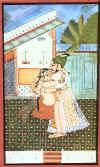 |

